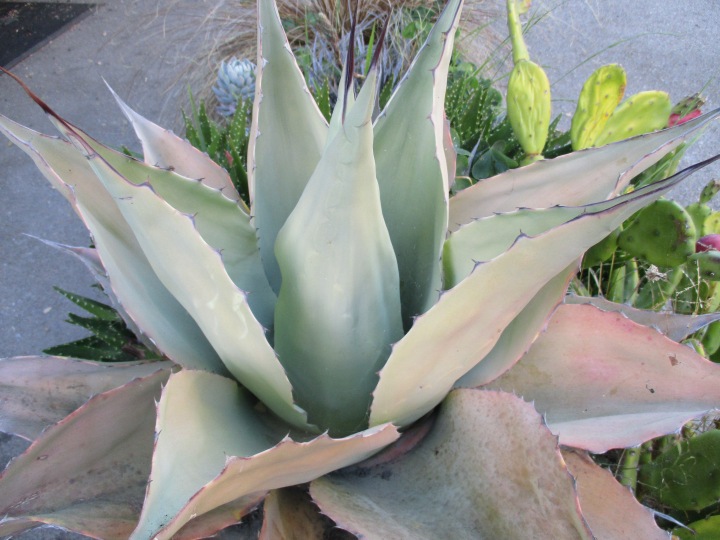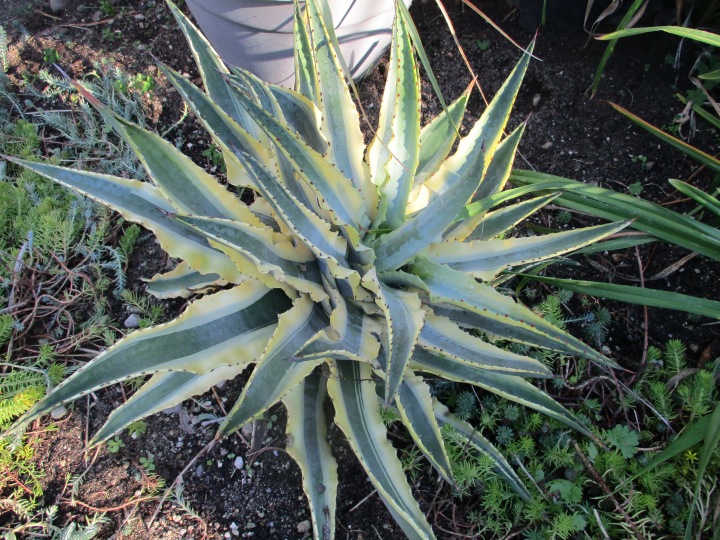If one of these six different agaves happens to be the blue agave from which tequila is made, I would not know. I only know that all six are various specie or cultivars of the Agave genus. The sixth picture is that of the common century plant, Agave americana, which is not used for tequila. I have no idea what the other five are. The fifth looks like it could possibly be a picture of Agave victoriae, but if I remember correctly, I was specifically told that it is not.
All six of these agaves were procured by my colleague. The first specimen is still potted at the shops where we work. The second specimen was relocated into a new landscape early last spring. The other four are within minimal proximity of each other, in a more established part of the landscape. There happens to be two agave pups in the Infirmary Nursery. At least one is from the agave in the second picture. I believe that the second pup is the same as well, but it seems to be developing teeth.
The wickedly sharp teeth and spines of most specie of agave are the main reason that agaves are not more practical in home gardens or small landscapes. It is not practical to try to snip the terminal spines off, because more develop with every new leaf. If they get enough space out of the way, agaves are bold and remarkably striking big perennials that are very resilient to arid climates.
There are no captions this week, because I do not know what to say about agaves that I know nothing about.
1.
2.
3.
4.
5.
6.
This is the link for Six on Saturday, for anyone else who would like to participate:
https://thepropagatorblog.wordpress.com/2017/09/18/six-on-saturday-a-participant-guide/
They’re handsome plants for all their air of mystery.
LikeLiked by 1 person
Thank you. It is unfortunate that they do not fit into many landscapes. They are ideal for the climate here.
LikeLiked by 1 person
II love agaves … I had one of 50cm in diameter (like the sixth) but a hard winter didn’t please it. Even in pot without watering during the winter, sheltered but not frost free, the cold killed the plant. I will always remember a huge A. americana in the garden of my wife’s grandfather (but in the south of France …)
LikeLiked by 1 person
The last one is likely an Agave americana, which gets quite big. It would not stay 50 centimeters for long! Only a few of the smaller agaves will stay that compact. The fifth happens to sty rather small. When Agave americana bloom, the floral stalks get as big as small trees. Then they die, and there is a horrible mess to clean up, followed by a herd of nastily thorny pups. Yet, we grow them anyway. They really are striking!
LikeLiked by 1 person
There seems to be some confusion with the numbers of the pictures. (The numbers are above the pictures, not below.) The fifth picture, which might have been confused with the sixth, really is a compact species, and might be Agave victoriae.
LikeLiked by 1 person
Fantastic and beautiful. Is number 6 Agave parrei? They are such great and easy going plants, as long as you don’t stroke them.
LikeLiked by 1 person
The sixth is likely Agave americana. The fifth, which might have been mistaken for the sixth is more similar to Agave victoriae than to Agave parryi. However, I was informed that it is not Agave victoriae; so it could be a cultivar of Agave parryi that I am not familiar with. I really do not know.
LikeLike
They are indeed rather beautiful plants – in a strange spiky way!
LikeLiked by 1 person
Yes. They are certainly distinct. Although I am none too keen on them, I can totally understand why so many are! They really are striking!
LikeLiked by 1 person
I have 2 agave plants growing in my yard, in SC PA, where they do well thru the winters. Amazing, hardy plants. Old times here call them century plants cos it used to be thought they only bloom occasionally, but that’s not true, even here. They stand there in the snow, and coated with ice, and then bloom almost every summer.
LikeLiked by 1 person
If they bloom annually, they might be Yucca filamentosa, which is native there, or another specie of yucca. There are not many states in America that do not have some sort of native yucca. Century plants are monocarpic, so each rosette dies after bloom. They can bloom annually, but only if they have a constant supply of mature rosettes to replace those that bloomed in the previous year. For there to be that many mature rosettes and that many maturing pups to replace them annually, there would need to be a huge colony. Their floral stalks are huge, like small trees. They are known as century plants because bloom is so rare in their native environments, where they grow very slowly in small colonies, or even singly. They are more tolerant to freezing weather than people realize. They live in some of the harshest desert climates where winter nights get wickedly cold.
LikeLiked by 1 person
So I call it agave and that’s wrong, thank you.
LikeLiked by 1 person
Oh, I do not know if it is wrong. It could be an agave. It is worth investigating. Agaves have thick fleshy leaves. Some yuccas do as well, but those that would be in your region likely have tough but thin leaves with spines only on the tips.
LikeLiked by 1 person
Yep, that’s it. Nasty points at the ends and very thin, strong leaves. Yucca!
LikeLiked by 1 person
How excellent! When I stated studying yuccas, I was fascinated that so many live in such cold climates. Yucca glauca lives as far north as Alberta! I believe that Yucca filamentosa is the most prominent native in your region, although yours could have been planted. I still think of yuccas as either xeric or tropical.
LikeLiked by 1 person
Thee are a lot of them in this area. We get them from other people we know. My grandmother was fascinated with them, cos they were ere exotic here ……50 years ago. 😊
LikeLiked by 1 person
The smaller specie and cultivars that were so rare years ago are becoming more popular here because garden space of modern homes is so limited.
LikeLiked by 1 person
#5 if my favourite, w/that red trim, altho they’re all striking plants. Have to wonder about Tim even considering giving them a stroke. Plant people!
LikeLiked by 3 people
Giving them a stroke is not as far fetched as it would seem. ‘Shark Skin’ and ‘Whale’s Tongue’ agaves have weirdly raspy foliar textures that are worth touching.
There are a few compact and ‘neat’ agaves like #5. Some of them look like fat pine cones. I have one in my own garden, although I do not know what it is. Althogh the big and sometimes sloppy Agave american is probably my favorite where space allows, I would prefer the smaller ones in my own garden. I just like the tailored look.
LikeLike
Lovely plants – the first is my favourite. I had an Agave americana in London. When we moved to Buckinghamshire it didn’t like the damp rural cold and promptly dies. Seeing your pic makes me realise I miss it…
LikeLiked by 1 person
Yes; they dislike dampness. I grew one for many years. It came with me into the Santa Cruz Mountains, and remains there with my former neighbor. It seemed to be quite happy, even with the shade and dampness, but the leaves were elongated and sloppy, and collected all the redwood debris the fell into them. What a mess! I will not argue wit the neighbor though. He loves it!
LikeLike
No. 5 is my favourite too, looks a bit more approachable. Very beautiful, unless you have to weed around them!
LikeLiked by 1 person
That is a good way of saying it. #5 Really is approachable, not only because it is compact, but because one knows where the spine are. It lacks teeth along the edges. #1 happens to be infested with oxalis, which is very difficult to separate from the wicked leaves. There is no way to get to the root of the problem without getting bitten.
LikeLiked by 1 person
And it hurts!!!!!
LikeLiked by 1 person
!!!!!!!!!!!
LikeLike
Never mind the tequila, the agaves are all fabulous. I love the one edged in red.
LikeLiked by 1 person
That seems to be the most popular. I think that it is the friendliest, and most practical. It does not need so much space.
LikeLike